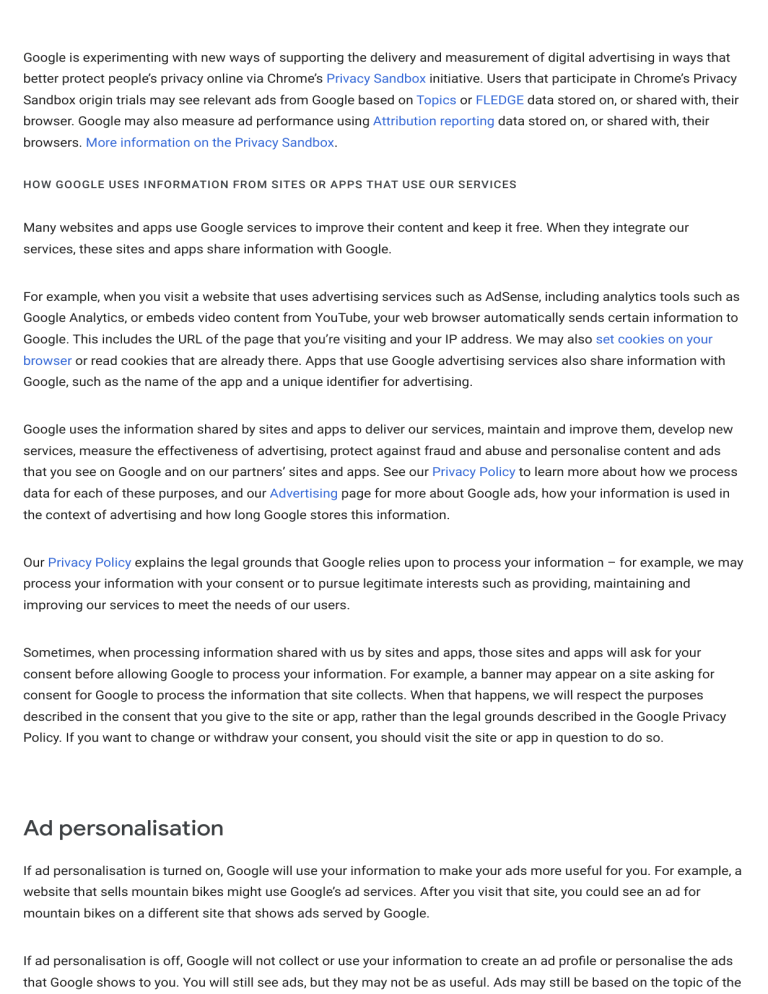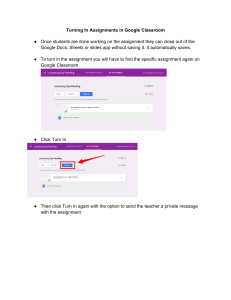How Google uses information from sites or apps that use our services – Privacy & Terms – Google
advertisement

Google is experimenting with new ways of supporting the delivery and measurement of digital advertising in ways that better protect people’s privacy online via Chrome’s Privacy Sandbox initiative. Users that participate in Chrome’s Privacy Sandbox origin trials may see relevant ads from Google based on Topics or FLEDGE data stored on, or shared with, their browser. Google may also measure ad performance using Attribution reporting data stored on, or shared with, their browsers. More information on the Privacy Sandbox. HOW GOOGLE USES INFORMATION FROM SITES OR APPS THAT USE OUR SERVICES Many websites and apps use Google services to improve their content and keep it free. When they integrate our services, these sites and apps share information with Google. For example, when you visit a website that uses advertising services such as AdSense, including analytics tools such as Google Analytics, or embeds video content from YouTube, your web browser automatically sends certain information to Google. This includes the URL of the page that you’re visiting and your IP address. We may also set cookies on your browser or read cookies that are already there. Apps that use Google advertising services also share information with Google, such as the name of the app and a unique identifier for advertising. Google uses the information shared by sites and apps to deliver our services, maintain and improve them, develop new services, measure the effectiveness of advertising, protect against fraud and abuse and personalise content and ads that you see on Google and on our partners’ sites and apps. See our Privacy Policy to learn more about how we process data for each of these purposes, and our Advertising page for more about Google ads, how your information is used in the context of advertising and how long Google stores this information. Our Privacy Policy explains the legal grounds that Google relies upon to process your information – for example, we may process your information with your consent or to pursue legitimate interests such as providing, maintaining and improving our services to meet the needs of our users. Sometimes, when processing information shared with us by sites and apps, those sites and apps will ask for your consent before allowing Google to process your information. For example, a banner may appear on a site asking for consent for Google to process the information that site collects. When that happens, we will respect the purposes described in the consent that you give to the site or app, rather than the legal grounds described in the Google Privacy Policy. If you want to change or withdraw your consent, you should visit the site or app in question to do so. Ad personalisation If ad personalisation is turned on, Google will use your information to make your ads more useful for you. For example, a website that sells mountain bikes might use Google’s ad services. After you visit that site, you could see an ad for mountain bikes on a different site that shows ads served by Google. If ad personalisation is off, Google will not collect or use your information to create an ad profile or personalise the ads that Google shows to you. You will still see ads, but they may not be as useful. Ads may still be based on the topic of the website or app that you’re looking at, your current search terms or on your general location, but not on your interests, search history or browsing history. Your information can still be used for the other purposes mentioned above, such as to measure the effectiveness of advertising and protect against fraud and abuse. When you interact with a website or app that uses Google services, you may be asked to choose whether you want to see personalised ads from ad providers, including Google. Regardless of your choice, Google will not personalise the ads that you see if your ad personalisation setting is off or your account is ineligible for personalised ads. You can see and control what information we use to show you ads by visiting your ad settings. How you can control the information collected by Google on these sites and apps Here are some of the ways you can control the information that is shared by your device when you visit or interact with sites and apps that use Google services: Ad Settings helps you to control ads that you see on Google services (such as Google Search or YouTube), or on non-Google websites and apps that use Google ad services. You can also learn how ads are personalised, opt out of ad personalisation and block specific advertisers. If you are signed in to your Google Account, and depending on your Account settings, My Activity allows you to review and control data that’s created when you use Google services, including the information that we collect from the sites and apps that you have visited. You can browse by date and by topic, and delete part or all of your activity. Many websites and apps use Google Analytics to understand how visitors engage with their sites or apps. If you don’t want Analytics to be used in your browser, you can install the Google Analytics browser add-on. Learn more about Google Analytics and privacy. Incognito mode in Chrome allows you to browse the web without recording web pages and files in your browser or Account history (unless you choose to sign in). Cookies are deleted after you’ve closed all of your incognito windows and tabs, and your bookmarks and settings are stored until you delete them. Learn more about cookies. Many browsers, including Chrome, allow you to block third-party cookies. You can also clear any existing cookies from within your browser. Learn more about managing cookies in Chrome.


